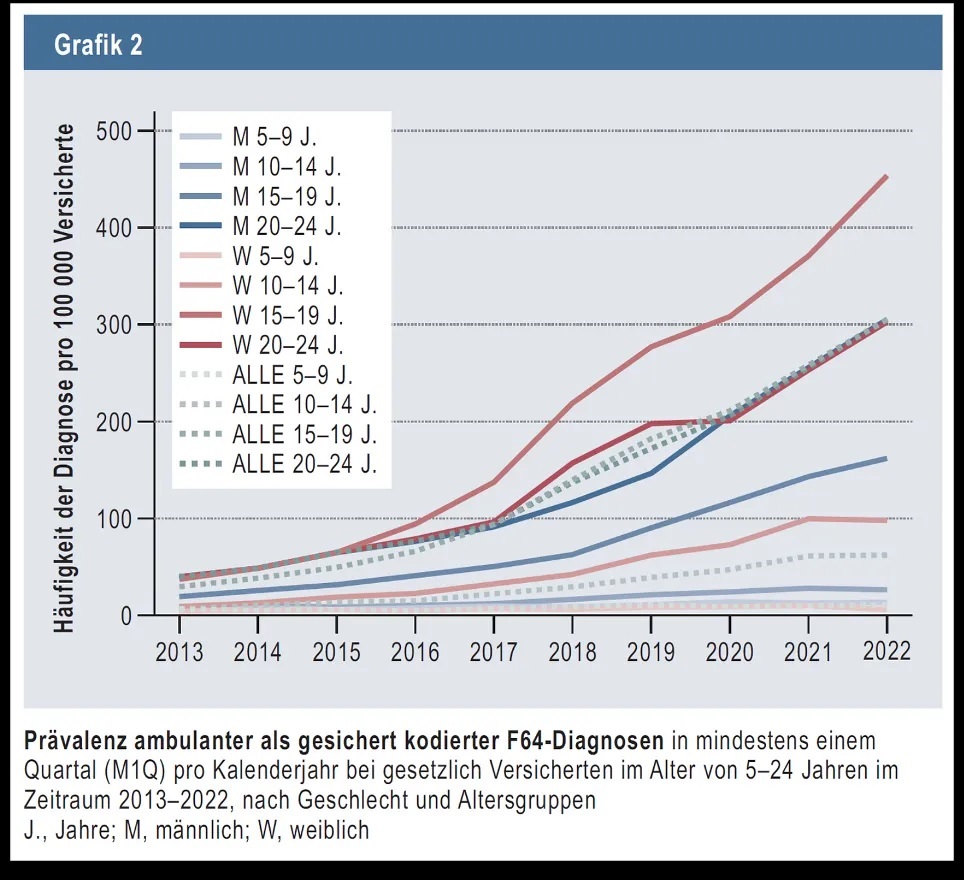Published on June 15, 2024
by Christina Buttons
Original: Reality’s Last Stand – Just a Phase: Most German Youth Outgrow Gender Identity Issues
A groundbreaking new study on insurance data suggests that the majority of German youth do not persist in their transgender identity after five years.
A new long-term study from Germany suggests that the majority of young people diagnosed with gender identity disorders do not continue to identify as such over time. The study examined insurance data over five years, revealing that more than half of young people aged 5-24 across every age subgroup diagnosed with “gender identity disorder” no longer had the diagnosis after five years. Specifically, the desistance rate was 72.7% in 15- to 19-year-old females and 50.3% in 20- to 24-year-old males. Among the whole group of 5- to 24-year-olds, only about 36.4% of those diagnosed in 2017 still had the diagnosis five years later, indicating that more than 63% desisted.
One of the strengths of this study is its comprehensive collection of outpatient billing data for all legally insured persons in Germany, providing a large and representative sample. Additionally, the long observation period from 2013 to 2022 offers valuable insights into long-term trends and changes in diagnosis rates.
The research also noted a dramatic rise in the number of young people being diagnosed with gender identity disorders. In 2013, there were 22.5 cases per 100,000 insured young people, but by 2022, this had increased to 175.7 cases per 100,000, representing an increase of nearly 681%. The study highlighted that, in almost all years, the highest prevalence of gender identity disorder diagnoses was found in 15- to 19-year-old females. In 2022, this age group had a prevalence rate of 452.6 cases per 100,000.

“W 15-19 J.” (females aged 15-19) represents the highest overall rate of increase.
The study also found that a large majority of those diagnosed with gender identity disorders had other mental health conditions. In 2022, 72.4% of individuals with a gender identity disorder diagnosis had at least one other psychiatric diagnosis. The most common co-occurring mental health issues included depressive disorders (affecting about 57.5% of females and 49.3% of males), anxiety disorders (34% of females and 23.5% of males), and borderline personality disorders (17.6% of females and 12.1% of males). Other frequent conditions were attention deficit/hyperactivity disorder (ADHD) and post-traumatic stress disorder (PTSD).
The researchers highlighted the “fluid” nature of gender identity during childhood and adolescence as a likely reason for the high desistance rates. Citing the U.K.’s Cass Review, the authors suggested the need for a comprehensive, standardized diagnostic procedure for youth experiencing gender-related distress.
The study suggests that many young people might resolve their gender incongruence without needing long-term medical treatment. The authors recommend that diagnostic stability and the high prevalence of concurrent mental disorders be considered when starting “gender-adjusting therapy” in adolescence.
They call for more research into cases of “low persistent diagnosis,” confirming that “the diagnostic persistence of less than 50% in all age groups in the 5-year follow-up corresponds to the literature.” This supports a growing body of research showing that gender dissatisfaction during adolescence is often temporary and tends to decline with age. This study aligns with recent findings from a long-term Dutch study, which found that most adolescents who expressed a desire to be the opposite sex no longer felt that way in adulthood.
Christina Buttons is an independent journalist with a forthcoming report on the connection between autism and gender dysphoria, as well as a detransition survey awaiting publication. She is developing a website that will feature the latest data, studies, and fact-checks that will debunk activist arguments related to gender medicine.

